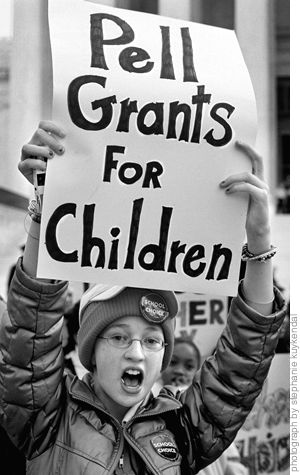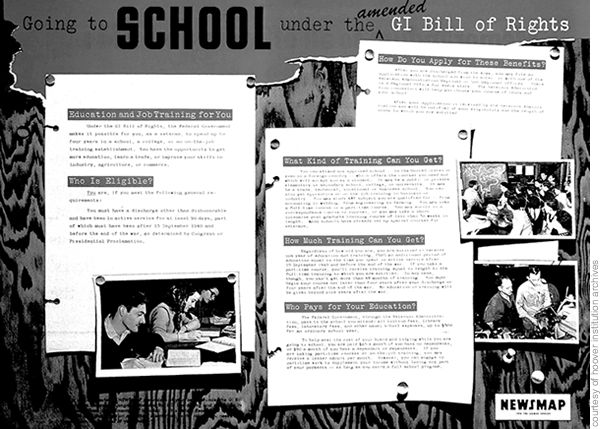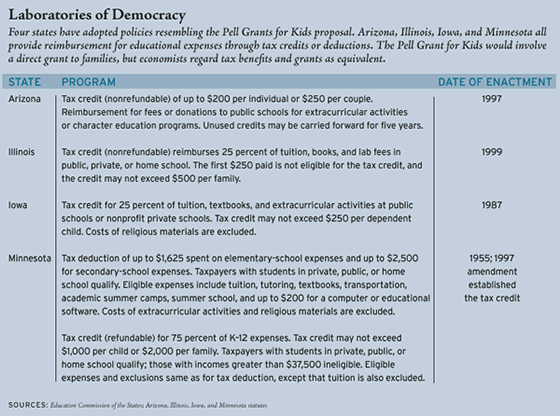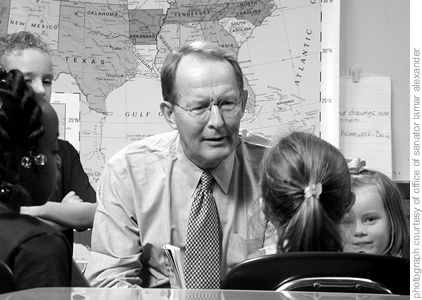
In 1990, as the new president of the University of Tennessee, I was trying to understand what had made American colleges and universities the best in the world. I asked David Gardner, then the president of the University of California, why his university has such a tradition of excellence. “First,” he said, “autonomy. The California constitution created four branches of government, with the university being the fourth. The legislature basically turns over money to us without many rules about how to spend it.
“The second is excellence. We were fortunate, at our beginning, to have a corps of faculty dedicated to high standards. That tradition has continued. And third, generous amounts of federal-and state-money have followed students to the schools of their choice. That has increased opportunity for those who couldn’t afford college, created choices that make good fits between the student and the school, and stimulated competition that encouraged excellent programs.”
Autonomy. High standards. Government dollars following students to the schools of their choice. That was the formula for the GI Bill, passed by Congress in 1944. The program gave World War II veterans scholarships redeemable at any accredited institution, public or private. Those veterans who didn’t hold a diploma could even use the scholarships at Catholic high schools. With these scholarships came few federal rules, thus preserving the universities’ autonomy. And by allowing students to choose their college, the GI Bill encouraged excellence and discouraged weak programs.
Not all university leaders welcomed the program. “It will create a hobo’s jungle,” warned legendary University of Chicago president Robert Hutchins. Instead, the GI Bill became the most successful piece of social legislation Congress ever enacted. It became the model for the federal grants and loans that today follow 58 percent of America’s college students to the schools of their choice. In 1972, when Congress debated whether future federal funding for higher education should go directly to institutions or be channeled through students, the model of the GI Bill helped carry the day for the latter approach, which was surely the right one. Pell Grants (named for Sen. Claiborne Pell, D-R.I.), Stafford Loans, and other forms of financial assistance to students followed. This year the federal government will spend nearly $17 billion on grants and work-study programs and will provide an additional $52 billion in student loans.
Rarely has the federal taxpayer gotten so much bang for the buck. These federal vouchers trained the “greatest generation” and made it possible for a greater percentage of Americans to continue into higher education than in any other country. At the time of the GI Bill’s passage in 1944, only about 6 percent of Americans held a four-year college degree. Today that figure stands at 26 percent.
Moreover, these scholarships have strengthened public institutions. At the end of World War II, 50 percent of American college students were attending public institutions. Today 76 percent choose to attend public colleges and universities. So many foreign students want to attend American universities that some institutions impose caps in order to make room for lower-achieving homegrown students. British prime minister Tony Blair is overhauling his nation’s system of higher education because he sees a growing gap between the quality of American and British universities. Likewise, former Brazilian president Fernando Henrique Cardoso recently told a small group of U.S. senators that the most important thing he would remember about his residency at the Library of Congress is “the uniqueness, strength, and autonomy of the American university.”
Meanwhile, federal support for elementary and secondary education has taken just the opposite approach-with opposite results. Instead of allowing tax dollars to follow students to the schools of their parents’ choice, the federal government gives $35 billion directly to the schools themselves (or to the states, which then give it to schools). In addition, thousands of pages of federal and state regulations govern how these funds are spent, thereby diminishing each school’s autonomy. Measured by student learning, rarely has the taxpayer gotten so little bang for so many bucks. In 1999, 8th-grade students in this country were ranked 19th in math and 18th in science compared with 38 other industrialized nations. The National Assessment of Educational Progress, known as the nation’s report card, shows other alarming trends. For example, between 1996 and 2000, the gap between affluent and poorer U.S. students actually widened in seven out of nine key indicators-like reading, math, and science. Two out of every three African-American and Hispanic 4th graders could barely read. Seventy percent of children in high-poverty schools scored below even the most basic level of reading.
 |
| The GI Bill became the most successful piece of social legislation Congress ever enacted. It is the model for the federal grants and loans that today follow 58 percent of America’s college students to the schools of their choice.
|
Enhancing Local Control
It is time to try a different funding approach, and Pell Grants, the college scholarships offered to low-income students, provide a useful model. Congress should enact “Pell Grants for Kids,” which would provide a $500 scholarship to each middle- and low-income child in America. Children could use these scholarships at any public or private school or for any educational program, such as private tutoring. Homeschooled children would also be eligible for the scholarship, as long as the money was spent on an accredited educational program. Overall, the grant would be available to about 60 percent of America’s 50 million primary and secondary school students, those whose families earn $53,000 or less. It would put the parents of approximately 30 million children directly into the education marketplace, each of them armed with a $500 grant, thereby encouraging choice and competition.
This idea has a distinguished lineage. In the late 1960s, Theodore Sizer, then at the Harvard Graduate School of Education, proposed a “Poor Children’s Bill of Rights” that would have supplied scholarships of $5,000 per child to the poorest half of children in the United States, for use at any accredited school, public or private. In 1992, while I was serving as secretary of education under President George H.W. Bush, the president asked Congress to appropriate a half billion dollars to create a pilot “GI Bill for Kids.” The program would have awarded $1,000 scholarships to 500,000 children in states and cities that wanted to try the idea, but the Democrat-controlled Congress refused to enact it.
The most important point to make here is that most of this new scholarship money is likely to be used at the public schools that nine out of ten students now attend. I believe parents are likely either to give the money to their school to meet its general needs or to seek the school’s advice on how best to spend the money to help their child. Surveys show that while many Americans are discouraged about the state of education generally, most parents support their own child’s public school. Parents in affluent school districts regularly augment their schools’ budgets with contributions for extra programs, particularly in the arts. Pell Grants for Kids would give children of low- and middle-income parents the same opportunity.
Pell Grants for Kids would provide more federal dollars for schools while also encouraging more local control-I mean more control by parents and teachers-over how that money is spent. Once parents make the decision about where the $500 will be spent, the principal and teachers in that school or program decide how it will be spent. For example, in a public middle school with 600 students, if two-thirds of the children are eligible for the grant, that’s $200,000 in new federal dollars each year following those children to that school. This would be manna from heaven for schools, many of which engage in time-consuming charity sales to net $500 or $1,000 for needed programs and projects. Enterprising principals surely would design programs to attract parents’ investment-perhaps an after-school program, an extra math teacher, or an intensive language course. And if they didn’t, parents would have the option to spend the money on another accredited educational program that suited their child’s needs, such as tutoring.
Aside from stimulating competition, these new federal funds would help to narrow the gaps in spending between wealthy and poor districts and make more real the promise that no child will be left behind. For example, in Bryan, Texas, property values average about $128,000 per student. Next door is College Station, home of Texas A&M University, where property values are $305,000 per student. As a result, College Station is able to collect far more in property taxes and its schools thus spend twice as much per student as those in Bryan. Last year Herman Smith, superintendent of schools in Bryan, told me, “College Station is talking about cuts in programs and personnel that we could only dream of.”
About 90 percent of Bryan’s 13,500 students would be eligible for the $500 Pell Grants for Kids, putting more than $6 million in new federal dollars into the hands of Bryan parents. They could then provide more funds to Bryan’s public schools, as is likely, or use the scholarship to help pay for enrichment programs or private school tuition. Bryan would still have fewer dollars to spend than College Station, but the gap would narrow.

Overcoming Objections
Let’s consider some questions and criticisms that might accompany the Pell Grant for Kids proposal:
• In a time of tight budgets, can the nation afford to offer $500 scholarships to 30 million schoolchildren? If it were enacted today, Pell Grants for Kids would cost $15 billion a year. A number of measures could be taken to ease the burden. First, implement the program gradually, providing $500 scholarships only to kindergarten and 1st graders in the initial year. This would cost just $2 billion. Second, over the next several years, devote most of the new appropriations for K-12 education (not related to children with disabilities) to Pell Grants for Kids. Done this way, it would not take many years to fully fund the scholarships while staying within a reasonable budget. For instance, if Congress had allocated two-thirds of all new federal spending (non-disability related) on K-12 education since 1992 to this program, $10 billion would have been available for scholarships this year-enough to provide full $500 scholarships to all middle- and low-income children in kindergarten through the 8th grade.
Or consider this: In just the first two years of the current administration, Congress appropriated $4.5 billion in new dollars for K-12 education (not counting another $3 billion more for children with disabilities). That $4.5 billion would have been enough to fully fund $500 scholarships for all nine million low- and middle-income children in kindergarten through 3rd grade.
• Aren’t K-12 schools and colleges so different that the Pell Grant analogy is invalid? It is true that schools and colleges sometimes emphasize different public purposes. For example, schools are asked to teach children what it means to be an American, to inculcate moral values, and to make up for poor parenting. Universities have research and public service missions that schools don’t share. But the core mission of both schools and colleges is the same: teaching and learning. Most high schools teach some college courses. Most community colleges teach some high-school students. That is why it is so odd that the way the federal government funds K-12 education is so different from the way it funds colleges.
• Aren’t you overlooking some real problems that colleges have? No doubt universities have significant problems. Some college students don’t pay back their loans. Some for-profit institutions are shams. Some courses are weird. Some tenured faculty members are worthless. In the context of rising tuition costs, there is too little interest in creating a less leisurely university calendar, in proposals such as requiring professors to work over the summer. Such abuses are the price of institutional autonomy and choice. Overall, however, American colleges and universities are by far the best in the world-and therefore useful models for how to improve our other educational institutions.
• Can we trust middle- and low-income parents to spend $500 wisely on their child’s education? I would remind those who make this condescending argument that Congress currently appropriates $8 billion each year to provide childcare vouchers to 2.3 million low-income parents. These parents may use the voucher at any licensed center, public, private, or religious. Likewise, 9.5 million low-income students may spend their federal student aid dollars at any accredited college. If Congress trusts low-income citizens to choose childcare and higher education providers for themselves, why not trust them to spend $500 on K-12 education programming for their children? In addition, because of our experience using established accrediting agencies to monitor Pell Grants for colleges, it should be relatively easy to create a similar system to make sure that Pell Grants for Kids are not spent on fly-by-night operations.
• Will more federal funding mean more federal control over education? Pell Grants for Kids would actually reduce federal control over education. The current funding process dictates how federal dollars are to be spent and imposes heavy regulations on local schools. Letting federal dollars follow children to the school of their parents’ choice would put control back into the hands of parents and teachers.
• Would Pell Grants for Kids violate the principle of separation of church and state? Federal grants have followed students to parochial colleges since World War II and to parochial daycare centers since 1990.
• Will giving individual schools so much autonomy leave some mired in mediocrity? Autonomy need not mean a lack of accountability. The No Child Left Behind Act requires states to establish tough academic standards and to measure students’ and schools’ performance on an annual basis. With these accountability systems in place, the argument for choice is that much stronger. Parents will have the knowledge of school performance to make informed choices about where to spend their new federal dollars. For this reason, students who decide to use their $500 scholarships at private schools would still be required to participate in their state’s testing program.
• Why not let all Title I money follow children to the schools of their choice? For now, I believe a gradual approach is warranted. The nation should begin by letting parents control how most, not all, of newly appropriated federal dollars for K-12 education are spent. Let’s monitor parents’ spending patterns and school performance for a while and then evaluate whether to expand the program.
• But private school tuition costs far more than $500. Correct. So those who worry that vouchers will hurt public schools should relax. But six hundred parents armed with $500 each can exercise $300,000 in consumer power at a public middle school. Five hundred dollars can also help pay for language lessons or remedial help. At Puente Learning Center in South Los Angeles, Sister Jennie Lechtenberg teaches students of all ages English and clerical skills at an average cost to the center of $500 per year.
 |
| “Enacting Pell Grants for Kids should be the next central thrust of federal efforts to improve the nation’s schools,” writes Senator Alexander, who served as secretary of education in the George H.W. Bush administration.
|
Toward Better Schools
Of course by themselves Pell Grants for Kids would not create the best schools in the world. As David Gardner said, it took autonomy and high standards in addition to generous funding following students to schools of their choice to help create the finest university system in the world. To increase schools’ autonomy, Congress should provide generous support to the charter school movement, offer waivers from federal rules to successful school districts, and use its oversight power to simplify federal laws and regulations. To help schools aspire to the excellence most colleges enjoy, Congress needs to give schools more flexibility in administering the mandates of No Child Left Behind. To make it easier for schools to pay teachers more for teaching well, just as colleges do, Congress should encourage the National Board for Professional Teaching Standards and other efforts to reward outstanding teachers. These organizations, in turn, must make the measure of students’ progress a key ingredient in a teacher’s evaluation.
It is a mistake to expect that merely switching to the higher education model for funding is all Congress needs to do to help transform public schools. To help children arrive at school ready to learn, Congress should heed President Bush’s challenge to strengthen Head Start by improving coordination, emphasizing cognitive skills, increasing accountability, and involving governors. So that state and local governments can remain financially sound enough to support good schools, Congress should keep its promise to end unfunded federal mandates. So that children can learn what it means to be an American, Congress should help states put the teaching of American history and civics back in its rightful place in school curricula.
Finally, no plan for better schools is complete without better parenting. In his research James Coleman found that, until a child is 14, parents are twice as important as school for the child’s learning. Yet the United States has gone from a society that values the job of being a parent to one that has been waging a war on parents. Liberal divorce laws and the diminished importance of marriage, higher taxes, poor schools, trash on television, unsafe streets, uncontrolled illegal drugs, and inflexible work arrangements have all made it harder for parents raising children. No part of American society has paid a higher price for this than our schools. Giving every middle- and low-income child a $500 scholarship to help encourage choice within education is a start, but only a start, toward putting government and society squarely on the side of parents raising children.
Nonetheless, enacting Pell Grants for Kids should be the next central thrust of federal efforts to improve the nation’s schools. For the past half century, the United States has actively supported the expansion and improvement of higher education through a generous funding system that encourages autonomy, choice, and competition. Our institutions of higher education have helped produce the research that has been responsible for creating half our new jobs since World War II. They have sculpted an educated leadership and citizenry that have made our democracy work and made it possible to defend our freedoms. It is past time to take the formula that has worked so well to help create the best colleges in the world and use it to help create the best schools for our children.
Lamar Alexander, R-Tennessee, is a U.S. senator. He served as U.S. secretary of education from 1991 to 1993.


